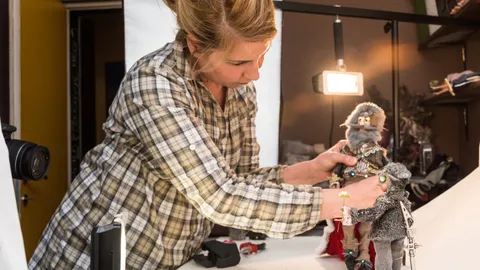How to Create a Video: The Ultimate Guide to Video Production
In today's digital age, video content has become a powerful tool for communication and engagement. Whether you're a business owner, a content creator, or simply someone looking to express their creativity, knowing how to create a compelling video is essential. In this ultimate guide to video production, we will take you through the step-by-step process of creating a high-quality video that captivates your audience.
Introduction: The Power of Video
Video has the unique ability to convey emotions, tell stories, and deliver messages in a way that captures attention and engages viewers. It allows you to communicate not only through spoken words but also through visuals, music, and other audio elements. Video content has proven to be highly effective in various domains, such as marketing, education, entertainment, and personal expression.
Pre-production
Before diving into the video production process, it's crucial to plan and prepare adequately. This phase sets the foundation for a successful video project.
Defining your goals and target audience
First and foremost, determine the purpose of your video. Are you trying to promote a product or service? Educate your audience? Tell a compelling story? Understanding your goals will guide all subsequent decisions throughout the production process. Additionally, identify your target audience and tailor your video to their preferences and interests.
Crafting a compelling story or message
Every great video begins with a captivating story or message. Take the time to brainstorm and develop a concept that resonates with your audience. Whether it's a narrative-driven storyline or a persuasive argument, a well-crafted script will serve as the backbone of your video.
Planning the logistics
Consider the practical aspects of your video production, such as budget, timeline, and available resources. Create a detailed plan that includes tasks, deadlines, and responsibilities. This will help ensure a smooth and organized production process.
Scriptwriting and Storyboarding
Once you have a clear vision for your video, it's time to translate it into a script and storyboard.
Developing a script
Write a script that outlines the dialogue, narration, and actions that will take place in your video. Structure it in a way that captures and maintains the viewer's attention from start to finish. Use concise and impactful language, and make sure the script aligns with your overall message and goals.
Creating a storyboard
A storyboard is a visual representation of your script, showcasing each shot or scene in a series of sketches or images. It helps you visualize the flow of your video and ensures that all necessary shots are planned. Consider camera angles, transitions, and any visual effects you intend to incorporate.
Gathering Equipment and Resources
To create a high-quality video, you'll need the right equipment and resources.
Cameras and lenses
Choose a camera that suits your needs and budget. Consider factors such as resolution, frame rate, and low-light performance. Additionally, select the appropriate lenses for capturing different shots and achieving desired visual effects.
Lighting and audio equipment
Proper lighting is essential for creating a visually pleasing video. Invest in lighting equipment that allows you to control the intensity, direction, and color temperature of the light sources. Additionally, ensure clear and high-quality audio by using external microphones and audio recording devices.
Props, costumes, and set design
Depending on the nature of your video, you may require props, costumes, and well-designed sets to enhance the visual appeal and convey your intended message effectively. Pay attention to details that contribute to the overall production value.
Setting Up the Shoot
Now that you have everything you need, it's time to set up your shoot.
Choosing the right location
Select a location that aligns with your video concept and provides the desired atmosphere. Consider factors such as lighting conditions, background noise, and accessibility. If shooting outdoors, be mindful of weather conditions and potential distractions.
Setting up the camera and lighting
Position your camera to capture the desired frame and angle for each shot. Experiment with different camera settings, such as aperture and shutter speed, to achieve the desired look. Set up the lighting equipment to create the appropriate mood and highlight key elements within the frame.
Directing talent and capturing the shots
If your video involves actors or presenters, provide clear instructions and guidance to ensure their performances align with your vision. Take multiple takes of each shot to have options during the editing process. Don't be afraid to experiment and explore creative angles and perspectives.
Filming Techniques
During the production phase, consider various filming techniques to enhance the visual appeal and engagement of your video.
Framing and composition
Compose your shots thoughtfully, considering the rule of thirds, leading lines, and balance within the frame. Experiment with different framing techniques, such as close-ups, wide shots, and aerial perspectives, to add depth and visual interest to your video.
Camera movements
Dynamically move your camera to add energy and visual excitement to your shots. Utilize techniques like panning, tilting, tracking, and dolly shots to create smooth and immersive visuals. However, ensure that camera movements are purposeful and serve the narrative or message of your video.
Continuity and shot sequencing
Maintain consistency and continuity throughout your video by ensuring that shots flow seamlessly from one to another. Consider shot sequencing techniques like shot-reverse-shot, match cuts, and cross-cutting to enhance storytelling and maintain viewer engagement.
Editing and Post-production
Once you have captured all the necessary footage, it's time to edit and polish your video.
Importing and organizing footage
Transfer your footage to a computer and import it into a video editing software of your choice. Organize your clips into folders or bins based on the scenes or shots they belong to. This will help streamline the editing process and make it easier to locate specific footage.
Cutting and arranging clips
Review your footage and select the best takes for each shot. Trim and arrange the clips in the desired sequence, ensuring smooth transitions between shots. Pay attention to pacing and rhythm to maintain viewer engagement throughout the video.
Adding transitions, effects, and music
Enhance the visual flow of your video by adding appropriate transitions between shots. Experiment with different effects and visual enhancements to elevate the overall look and feel of your video. Additionally, incorporate suitable music or sound effects to create mood and evoke emotions.
Color grading and audio enhancement
Adjust the colors and tones of your video through color grading to achieve a consistent and visually appealing look. Pay attention to color balance, contrast, and saturation. Additionally, enhance the audio quality by removing background noise, adjusting volume levels, and adding any necessary voice-overs or sound effects.
Exporting and Distribution
With your video edited and polished, it's time to export it in the appropriate format and prepare it for distribution.
Choosing the right video format and resolution
Consider the platforms and devices your video will be viewed on. Choose a video format and resolution that ensures compatibility and optimal viewing experience across various platforms and screen sizes.
Optimizing for different platforms
Tailor your video for specific platforms, such as social media or video hosting websites. Optimize the video's title, description, and tags to improve discoverability. Consider creating different versions or edits of your video to cater to different audience preferences.
Promoting and sharing your video
Leverage social media, email marketing, and other online channels to promote and share your video. Engage with your audience through comments, shares, and discussions. Collaborate with influencers or industry experts who can help amplify the reach of your video.
READ MORE :
Video Marketing Strategy: The Ultimate Guide
How to Create the Perfect Promo Video
Conclusion
Creating a video can be a rewarding and impactful endeavor. By following the steps outlined in this ultimate guide to video production, you'll be equipped with the knowledge and tools to create compelling videos that captivate your audience. Remember to plan meticulously, unleash your creativity, and continually refine your skills to produce videos that leave a lasting impression.
Every brand has a unique story, and telling it right can significantly boost your revenue. With Video Production in Melbourne, Adelaide, and Sydney by Vimi, experience a tailored approach that captures your essence and resonates with your audience, driving unparalleled results.
FAQs
1. What equipment do I need to create a video?
To create a video, you'll need a camera, lenses, lighting equipment, audio equipment, and possibly props or costumes depending on your video's requirements.
2. How can I improve the quality of my video's audio?
Invest in external microphones and audio recording devices to capture clear and high-quality audio. Ensure proper placement and adjust audio levels during the editing process.
3. Which video editing software should I use?
There are various video editing software options available, such as Adobe Premiere Pro, Final Cut Pro, and DaVinci Resolve. Choose one that suits your needs and learn its features and functionalities.
4. How long should my video be?
The optimal video length depends on the platform and purpose of your video. Generally, aim for concise and engaging content, keeping in mind that viewers have shorter attention spans.
5. How can I promote my video effectively?
Utilize social media platforms, email marketing, and collaborations with influencers or industry experts to promote and share your video. Engage with your audience and encourage them to share your video with others.





